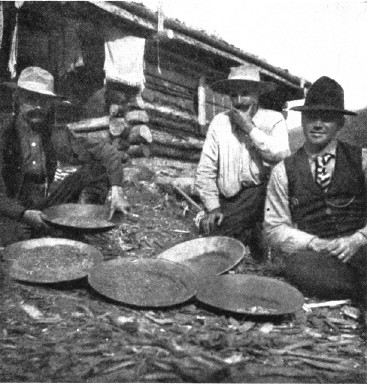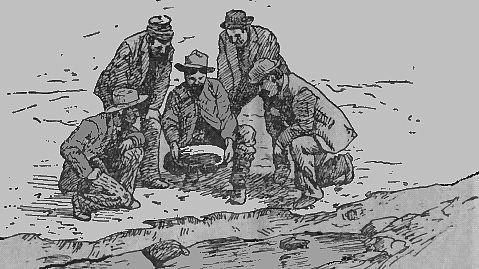Placers have also been formed by slides which, however, come from older gravel beds and must, therefore, be considered to have a water origin. An excellent example of such an occurrence was observed at Morris Ravine, where a mass of auriferous material several miles in extent was found to be gradually moving forward into the workings as hydraulic mining proceeded from below, clearing away the deposit to bed-rock. There is no doubt but that landslides contribute in many instances to the accumulation of auriferous materials and possibly to a much greater extent than is usually suspected. As a rule gold occurs on or close to bed-rock. However, many large bodies of gravel have been found in which the gold has been uniformly distributed from surface to bed-rock. The coarser gold is usually found in the lower portion of the deposit unless the stream has built up from a lower base-level with comparatively long intervals of activity followed by others of inactivity when no change in level occurred. Under such circumstances different levels or zones of gravels can readily be traced out, in which considerable variation in size of gold grains is noted and there may be several successive layers of coarse gold with quite a distance, vertically, intervening.
The occurrence of gold in gravel deposits may be still further complicated by the crossing of rivers, the gravel deposits formerly built up being washed out and redistributed by the subsequent action of another river running in a somewhat different direction, which action may be repeated a number of times, with added confusion as to occurrence of gold-content and thickness and character of the gravel deposit. Again the course of a stream may be changed or it may be split up into two or more parts by landslides, glacial action, flows of lava and the choking up of the channel owing to excessive wash from above without sufficient grade to bear the debris away and thus preventing its accumulation. The splitting up or spreading of rivers brought about by the accumulation of debris in the channels may result in the formation of a gravel deposit extending over large areas, in which case they resemble to a marked degree lacustrine or delta like deposits.
The cemented gravels commonly known as "cement gravel", calcrete or caliche, may consist of volcanic materials of brecciated or conglomerated character or may be a quartz conglomerate cemented by ferrous oxide or iron pyrite, lime or siliceous materials, but is a term of variable signification. Ferrous oxide results from the oxidation of pyrite through contact with a continuous flow of surface waters percolating through the deposits blue is the characteristic color. With an intermittent movement of the surface water and where oxidation is rendered more complete by the action of atmospheric agencies, ferric oxides result which are seldom effective bonds such gravels are red. The so-called "pyritic cementation" is probably produced by uprising sub-surface currents, while siliceous and calcareous cementation is caused by surface waters. Here too cementation is seldom complete, the deposits being an agglomerate rather than a conglomerate the distinction if any being that the first distintegrates into its original constituents, while the latter does not. Pipe clay, a more or less indurated clay, is usually a characteristic formation accompanying gravel deposits and especially the "deep" gravel.
The deep gravels are usually composed of layers of gravel, sand, volcanic ash or clay and lava usually in the order given from the bottom up. About the only regularity in occurrence is in the position of the gravel and lava, the former being at the bottom and the latter at the top of the deposit. The layers of sand and ash are flat and lenticular, varying in thickness from 6 to 8 and 12 yards, while their lateral extent is considerably greater. The volcanic materials consist of scoria, sand, mud or basalt, and owing to their extreme hardness have resisted wear they now stand as mesas. The lava may have flowed into the river channels or been washed in as rounded, water-worn boulders. The most common form of material comes from the consolidation of volcanic mud and ash and occurs in light colored, fine-grained, homogeneous beds. Occasionally lava occurs interstratified with the gravel. The upper portions of rivers form natural sluices, where, owing to the velocity of the stream, gravel deposits are rare, coarse, and thin. The earliest permanent deposit of gravel takes place when the gradient of a stream becomes sufficiently flat or the valley widens so that the waters of the stream are no longer confined. In the latter case, a "fan" results at the debouchure of the stream from the narrow into the broader valley or into the plains. They are especially characteristic of tropical and other rivers subject to periodic high floods. Rivers debouching from the Himalayas into the Gangetic and Brahmaputra plains show this feature especially well, gold and coarse gravel being deposited only within a short distance of the debouchure. Further out, sand, and still further, fine mud, are deposited. Owing to changes in the direction of rivers or in the level of river valleys, gravels may be covered by sands or clays, and those again by gravels. Since gold is deposited with gravels, there may therefore occur in the history of the alluvium of any given valley, two or more periods of auriferous deposition.
It may be stated as a general rule that the deposition of gold in gravels arises from a slowing in the velocity of the transporting waters. The slowing may be general, as in the case above-mentioned, or may be local. The latter occurs when the river crosses the strike of schistose or slaty strata, the upturned edges of which act as natural riffles, the gold being deposited in the crevices of the slate or schist. The down-stream side of a rocky bar is for the same reason a convenient lodging place for auriferous gravels, as also is the inner or concave side of a river bend. An uneven bottom is favorable to deposition, and a soft bottom is likely to retain more gold than a hard one. A marked concentration of gold is observable towards the bottom of placer gravels, the richest deposits, as a rule, lying on "bed-rock." Where, however, conditions have permitted, without prior scouring of the bed, deposition on clays or on cemented sands, the upper surfaces of these prevent the downward progress of gold, and are then known as "false bottoms." The motion of a grain of gold in course of transport along a stream bed is neither forward horizontally due to the force of the stream current nor downwards vertically due to the force of gravity, but is in a direction compounded of the two. Lateral currents may tend to deflect the falling grain sidewise, forming deposits on the beaches of the inner or concave side of the river. It has recently been shown that the course of stream-waters is spiral when passing round river curves," thus explaining the deposit on the inner side, since the lower part of the spiral flow is from the deep outer to the shallow inner bank. The stream itself combining a progressive with a lateral motion may thus be said to screw itself like a corkscrew round a bend. The fall of gold in gravel is not, of course, continuous, but takes place only on disturbance of the gravel. This is generally effected by the force of the stream current. It has recently been suggested b that the necessary disturbance of the gravel is effected during a downward "creep" of the valley gravels entirely comparable to that well known to occur on hill-sides. Where gravels are absent from a stream bed owing to scour, there also gold is wanting.
Ideal rivers for the concentration of gold are those in which natural conditions approach most closely those of a long sluice ; they therefore possess even, rapidly-flowing waters, have a regular gradient, and are at times subject to minor floods. These conditions are practically fulfilled only in temperate zones. In tropical countries subject to monsoons, where rivers are in –high flood during a portion of the year, and are dry or nearly so during the remainder, the continuous concentration necessary to yield placer deposits of economic value is absent. Deposition of gold in these regions takes place only after the monsoon or rainy season, when the rivers are falling and when the boulders and pebbles on the surface of the gravels furnish convenient, but local, riffles. Under these conditions gold is deposited only in the tiny eddies formed by the passage of the falling flood waters over deposits of coarse gravel. It therefore occurs at the heads and tails of gravel banks and islands in the river-bed, and on the beaches of the inner sides of the river curves. The gold deposits are rarely more than a few inches below the surface of the gravel, and those formed at the close of a rainy season are scattered deep and wide by the monsoon floods of the ensuing season. Many economic investigations have failed from neglect to recognize the impossibility, under the foregoing conditions, of 'bottom" concentration. Surface concentration entirely akin to the above takes place locally and to a limited extent in many rivers in temperate regions, but in these rivers by far the greater portion of the gold is deposited on or near a "bottom," false or true, as a necessary consequence of the persistence, perhaps for centuries, of a stream in the same restricted channel.
Continue on to:
Paystreak Formation – Part
I
Return To:
All About Placer Gold
Deposits


